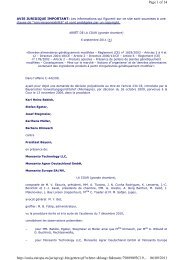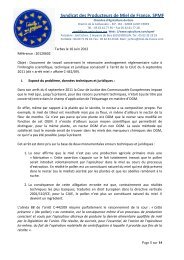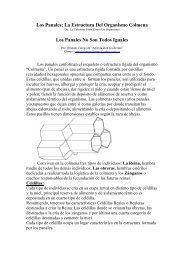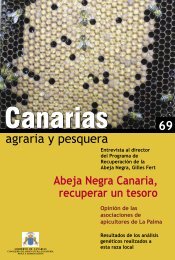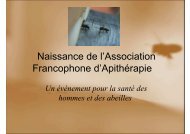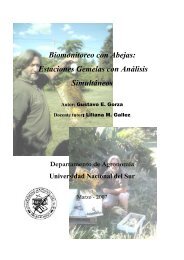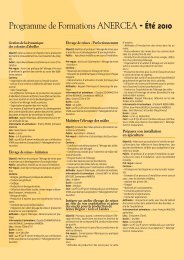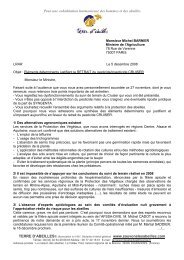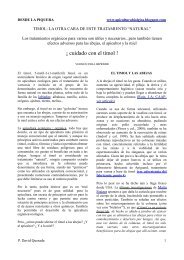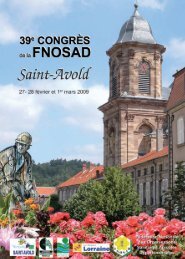Bruderer, C. <strong>et</strong> Hermieu, Y. (2008) Les abeilles vont-elles disparaître ? L'Oiseau magazine, (90), 24 - 27.Bruneau, E. (2006) Nutrition <strong>et</strong> malnutrition <strong>des</strong> abeilles. Biodiversité <strong>des</strong> plantes : une clé pour l'alimentation <strong>et</strong>la survie <strong>des</strong> abeilles. Comptes rendus Académie Agriculture de France, Séance du 14 juin 2006, 1-10.Bruneau, E. (2007) L'abeille porte-drapeau. Abeilles & Cie, (120), Editorial.Bühler, A., Lanzrein, B. <strong>et</strong> Wille, H. (1983) Influence of temperature and carbon dioxide concentration onjuvenile hormone titre and dependent param<strong>et</strong>ers of adult worker honey bees (Apis mellifera L.).Journal of lnsect Physiology 29, (12), 885-893.Burg<strong>et</strong>t, M., Akratanakul, P. <strong>et</strong> Morse, R. A. (1983) Tropilaelaps clarae : a parasite of honeybees in south-eastAsia. Bee World 64, 25-28.Caron, D., Burdick, E., Ostiguy, N. <strong>et</strong> Frazier, M. (2005) Mid-Atlantic Apiculture Research and ExtensionConsortium Survey Preliminaries. Department of Entomology, 501 Ag Sciences & Industries Bldg.,Penn State University, PA 16802 and Dept of Entomology, 250 Townsend Hall, University of Delaware,Newark, DE, 7 pages.Carpana, E., Vecchi, M.A., Lavazza, A., Bassi, S. <strong>et</strong> Dottori, M. (1990) Prevalence of acute paralysis virus(APV) and other viral infections in honeybees in Italy. Proceedings of the international symposium onrecent research on bee pathology. Ghent, BelgiumCelle, O. , Schur, F., Blanchard, P. <strong>et</strong> Faucon, J.P. (2008) <strong>Mortalités</strong> de <strong>colonies</strong> : recensement exhaustif <strong>et</strong>causes explicatives <strong>des</strong> cas de début d'année. A paraître.C<strong>et</strong>iom (2001) Tournesol : jamais les variétés n'ont été aussi performantes. Rapport.http://www.amsol.asso.fr/actualites/Touprogres.pdf, 2 pages.Charrière J.-D., Imdorf A. <strong>et</strong> Fluri P. (2003). Pertes de <strong>colonies</strong> en Suisse 2002/2003. Centre suisse derecherches apicoles, Berne (Suisse), 18 pages.http://www.alp.admin.ch/themen/00502/00538/00543/index.html?lang=fr&download=M3wBPgDB/8ull6Du36WenojQ1NTTjaXZnqWfVp7Yhmfhnapmmc7Zi6rZnqCkkIN4fXqCbKbXrZ6lhuDZz8mMps2gpKfo.Charrière, J.D., Imdorf, A., Koenig, C., Gallmann, S. <strong>et</strong> Kuhn, R. (2006) Cultures de tournesol <strong>et</strong>développement <strong>des</strong> <strong>colonies</strong> <strong>d'abeilles</strong> mellifères. Revue suisse d'agriculture 38, (5), 269-274.Chauvency, F. (1997) Dossier tournesol. Revue Française d'Apiculture, (579).Chauzat, M. P. <strong>et</strong> Pierre, J. (2005) L'importance du pollen pour l'abeille domestique. Le pollen <strong>et</strong> sescomposants. Bull<strong>et</strong>in Technique Apicole 32, 11-17.Chauzat, M. P., Faucon, J. P., Martel, A. C., Lachaize, J., Cougoule, N. <strong>et</strong> Aubert, M. (2006) A survey onpesticide residues in pollen loads collected by honey-bees (Apis mellifera) in France. Journal ofEconomic Entomology 99, (2), 253-262.Chauzat, M. P. <strong>et</strong> Faucon, J. P. (2007) Pestici<strong>des</strong> residues in beeswax samples collected from honey-bee<strong>colonies</strong> (Apis mellifera) in France. Pest Management Science 63, (11), 1100-1106.Chauzat, M. P., Higes, M., Martin-Hernandez, R., Meana, A., Cougoule, N. <strong>et</strong> Faucon, J. P. (2007) Presenceof Nosema ceranae in French honey bee <strong>colonies</strong>. Journal of Apicultural Research 46, (2), 127-128.Chauzat M.-P., Carpentier P., Martel A.C., Cougoule N., Porta P., Lachaize J. <strong>et</strong> al. (2008) The influence ofpesticide residues on honey bee (Hymenoptera: Apidae) colony health in France. EnvironmentalEntomology. In Press.105
Chen, Y., Zhao, Y., Hammond, J., Hsu, H.T., Evans, J. <strong>et</strong> Feldlaufer, M. (2004) Multiple virus infections in thehoney bee and genome divergence of honey bee viruses. Journal of Invertebrate Pathology 87, (2-3),84-93.Cintra, P., Malaspina, O., Bueno, O.C., P<strong>et</strong>acci, F., Fernan<strong>des</strong>, J.B., Vieira, P.C. , <strong>et</strong> al. (2005) Oral toxicityof chemical substances found in Dimorphandra mollis (Caesalpiniaceae) against honeybees (Apismellifera). Sociobiology 45, (1), 141-149.Clark, C. J. <strong>et</strong> Lintas, C. (1992) Chemical composition of pollen from kiwifruit vines. New Zealand. Journal ofPollen from kiwifruit vines 20, 337-344.Clément, H. (2006) En France la récolte de miel est passée…. Libération du 23 août 2006.Code Rural (2006) Liste <strong>des</strong> maladies contagieuses. In: Code Rural. Article D223-1 <strong>et</strong> D223-21.Coineau, Y. <strong>et</strong> Fernandez, N. (2007a) L'acariose. In : L'abeille mellifère - Maladies, parasites <strong>et</strong> autresennemis. Editions Atlantica. Collection Atlantisciences. 504 pages. Pages 109 -112.Coineau, Y. <strong>et</strong> Fernandez, N. (2007b) La nosémose. In : L'abeille mellifère - Maladies, parasites <strong>et</strong> autresennemis. Editions Atlantica. Collection Atlantisciences. 504 pages. Page 130.Colin, M. E., Bonmatin, J. M., Moineau, I., Gaimon, C., Brun, S. <strong>et</strong> Vermandere. J. P. (2004) A m<strong>et</strong>hod toquantify and analyze the foraging activity of honey bees: Relevance to the subl<strong>et</strong>hal effects induced bysystemic insectici<strong>des</strong>. Archives of Environmental Contamination and Toxicology 47, 387-395.Costanza, R., D’Arge, R., De Groot, R., Farber, S., Grasso, M., Hannon, B., <strong>et</strong> al. (1997) The value of theworld’s ecosystem and natural capital. Nature.387, 253-260.Cougard, M.J. (1999) La disparition mystérieuse <strong>des</strong> abeilles. Le Figaro du 2 novembre 1999.Cox-Foster, D.L., Conlan, S., Holmes, E.C., Palacios, G., Evans, J.D., Moran, N.A., <strong>et</strong> al. (2007) Am<strong>et</strong>agenomic survey of microbes in honey bee colony collapse disorder. Science 318, (5848), 283-287.Crailsheim, K., Riessberger Blaschon, B., Nowogrodzki, R. <strong>et</strong> Hrassnigg, N. (1999) Short-term effects ofsimulated bad weather conditions upon the behaviour of food-storer honeybees during day and night(Apis mellifera carnica Pollmann). Apidologie 30, (4), 299-310.Currie, R. W. <strong>et</strong> Gatien, P. (2006) Timing acaricide treatments to prevent Varroa <strong>des</strong>tructor (Acari : Varroidae)from causing economic damage to honey bee <strong>colonies</strong>. Canadian Entomologist 138, (2), 238-252.Cutler, G.C. <strong>et</strong> Scott-Dupree, C.D. (2007) Exposure to clothianidin seed-treated canola has no long-termimpact on honey bees. Journal of Economic Entomology 100, (3), 765-772.Dall, D.J. (1985) Unapparent infection of honey bee pupae by Kashmir and sacbrood bee viruses in Australia.Journal of physiology 106, (3), 461-468.Dawson, D. (1994) Are habitat corridors conduits for animals and plants in a fragmented landscape? A review ofthe scientific evidence. English Nature Research Report N° 94. P<strong>et</strong>erborough : English Nature.Day, S., Beyer, R., Mercer, A. <strong>et</strong> Ogden, S. (1990) The nutrient composition of honey bee collected pollen inOtago, New Zealand. Journal of Apicultural Research 29, 138-146.De Graaf, D.C, Vandekerchove, D., Dobbelaere, W., Pe<strong>et</strong>ers, J.E. <strong>et</strong> Jacobs, F.J. (2001) Influence of theproximity of American foulbrood cases and apicultural management on the prevalence of Paenibacilluslarvae spores in Belgian honey. Apidologie 32, (6), 587-599.106
- Page 1:
Mortalités, effondrements et affai
- Page 4 and 5:
M. François MOUTOUEpidémiologie g
- Page 6 and 7:
SOMMAIRELISTE DES TABLEAUX ........
- Page 9:
RÉFÉRENCES BIBLIOGRAPHIQUES......
- Page 16 and 17:
INTRODUCTIONL’environnement et l
- Page 18 and 19:
Les membres de ce groupe de travail
- Page 20 and 21:
Figure 1 : Population théorique mo
- Page 22 and 23:
Figure 2 : Facteurs influençant l
- Page 24 and 25:
Pour le calcul du taux de mortalit
- Page 26 and 27:
Agent pathogèneVespa velutinaAethi
- Page 28 and 29:
Tableau 3 : Les douze principaux vi
- Page 30 and 31:
1.2.2 Agents chimiquesLes abeilles
- Page 32 and 33:
• L’exposition résultant de l
- Page 34 and 35:
- Au Royaume-Uni, d’après le WII
- Page 36 and 37:
Par leur nature, ces types d’inci
- Page 38 and 39:
Le taux de protéine contenu dans l
- Page 40 and 41:
Tableau 4 : Teneur en protéines br
- Page 42 and 43:
1.2.3.4 Pratiques agricolesÉvoluti
- Page 44 and 45:
En conditions de laboratoire, semi-
- Page 46 and 47:
- des conditions climatiques, alter
- Page 48 and 49:
2 SITUATION SANITAIRE DE LA FILIÈR
- Page 50 and 51:
2.2 LA FILIERE APICOLE FRANÇAISE2.
- Page 52 and 53:
2.2.2 Les difficultés de la filiè
- Page 54 and 55:
2.3 CAUSES DES MALADIES DES ABEILLE
- Page 56 and 57: 2.3.1.2 Publications et rapports sc
- Page 58 and 59: Une étude consacrée aux viroses d
- Page 60 and 61: 2.3.2.2 Publications et rapports sc
- Page 62 and 63: Des cas de mortalités anormales d
- Page 64 and 65: Les informations disponibles pour l
- Page 66 and 67: aux colonies, même si, en théorie
- Page 68 and 69: A l’issue de l’étude des cause
- Page 70 and 71: Figure 3 : Organisation des structu
- Page 72 and 73: Toutefois, pour plusieurs raisons,
- Page 74 and 75: Plus particulièrement dans le doma
- Page 76 and 77: 2.4.1.4 Rôle de la professionDiff
- Page 78 and 79: 2.4.1.5 La formation sanitaire apic
- Page 80 and 81: 2.4.2 La pharmacie vétérinaire du
- Page 82 and 83: 2.4.2.2 Le traitement des autres ma
- Page 84 and 85: 3 RECOMMANDATIONSUne classification
- Page 86 and 87: 3.1 ÉPIDÉMIOSURVEILLANCE 44 DES M
- Page 88 and 89: Dans ce schéma, les données serai
- Page 90 and 91: La mission prioritaire de cet insti
- Page 92 and 93: • Création d’un guide de bonne
- Page 94 and 95: 3.2.6.7 Mise en place d’un contr
- Page 96 and 97: - viser une application stricte, da
- Page 98 and 99: 3.4.3 Étiologie multifactorielle d
- Page 100 and 101: peuvent être particulièrement per
- Page 102 and 103: CONCLUSIONLa réflexion menée au s
- Page 104 and 105: Anderson, D.L. et Trueman, J.W. (20
- Page 108 and 109: De Jong, D., Morse, R.A. et Eickwor
- Page 110 and 111: Faucon, J.P. et Chauzat, M. P. (200
- Page 112 and 113: Imdorf, A. et Gezig, L. (1999) Guid
- Page 114 and 115: Malone, L.A., Burgess, E.P.J., Chri
- Page 116 and 117: Ongus, J.R., Peters, D., Bonmatin,
- Page 118 and 119: Rothenbuhler, W.C. (1964) Behaviour
- Page 120 and 121: Wahl, O. et Ulm, K. (1983) Influenc
- Page 122 and 123: 121
- Page 124 and 125: • Aethina tumidaNom commun : le p
- Page 126 and 127: (Bailey et Ball, 1991). Les princip
- Page 128 and 129: pertes de colonies dans l’ensembl
- Page 130 and 131: Pour les vétérinaires spécialis
- Page 132 and 133: La dispersion des spores s’effect
- Page 134 and 135: Elle serait due au développement d
- Page 136 and 137: 5.3) Les virus sans association ave
- Page 138 and 139: d’échantillons de cas de CCD (30
- Page 140: consécutifs à chacun des usages p
- Page 143 and 144: Figure 10 (annexe 3) : Schéma d’
- Page 145 and 146: de ceux qui ne le sont pas, afin d
- Page 147 and 148: L’évaluation des risques a été
- Page 149 and 150: Figure 12 (annexe 4) : Carte des r
- Page 151 and 152: Figure 14 (annexe 4) : Exemples de
- Page 153 and 154: ANNEXE 6 : Estimation des pertes de
- Page 155: 154




